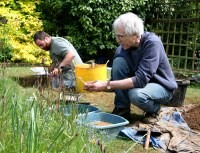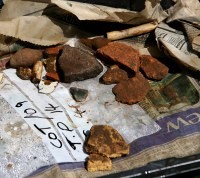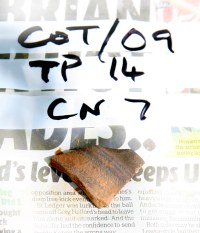“A single sherd of Romano-British pottery occurred here, and is in good condition. It is the only pottery from that context, and may represent evidence of occupation during that period. The small quantities of medieval pottery show that there was activity on the site in the 12th and 13th centuries, but then it appears to have been abandoned until the 16th century. There appears to have been low-level activity there since then.”
 This weekend we, and a dozen other properties in our village, hosted a team of archaeologists from the University of Cambridge. The team, led by Dr Carenza Lewis (well known to Time Team viewers), were intent on unearthing the secrets of the centuries locked in our gardens. So, armed with mattocks and buckets, we mucked in and set about digging out layer by layer a one cubic metre chunk of earth from various sites including our front garden.
This weekend we, and a dozen other properties in our village, hosted a team of archaeologists from the University of Cambridge. The team, led by Dr Carenza Lewis (well known to Time Team viewers), were intent on unearthing the secrets of the centuries locked in our gardens. So, armed with mattocks and buckets, we mucked in and set about digging out layer by layer a one cubic metre chunk of earth from various sites including our front garden.
Turf was first taken up, I say turf, our weed and moss-infested lawn is nothing to write home about. Then the first layer of top soil was hacked out and sieved through a 10mm mesh and any “finds” inspected and added to the first “context” tray. Given that our house was built in 1967 on old orchard land it was fairly unlikely that anything of particular interest would be found in that layer, our tame archaeologist and digger, Gary told us.
 A small sample of soil from the first 100 mm context layer was stored in a carefully labelled plastic bag and then the next layer scooped out. Marginally more interesting fragments began to emerge as layers were peeled away under the shade of our mountain ash: obvious fragments of red brick, tiny chunks of crumbly mortar, and a few sherds of pottery, lengths of clay pipe, one or two old nail heads were found in between the tiny chunks of napped, or worked, flint. Not huge quantities but enough from the time of the founding of Cambridge University 800 years ago, the mediaeval period and before, to pique the interest and to inspire further digging.
A small sample of soil from the first 100 mm context layer was stored in a carefully labelled plastic bag and then the next layer scooped out. Marginally more interesting fragments began to emerge as layers were peeled away under the shade of our mountain ash: obvious fragments of red brick, tiny chunks of crumbly mortar, and a few sherds of pottery, lengths of clay pipe, one or two old nail heads were found in between the tiny chunks of napped, or worked, flint. Not huge quantities but enough from the time of the founding of Cambridge University 800 years ago, the mediaeval period and before, to pique the interest and to inspire further digging.
Some oddities emerged such as “clinker” like layers of seemingly charred material that had a sooty smell and were leathery with surface markings. Dr Lewis was hard-pushed to identify these at the time. To our inexpert eyes they looked like pieces of charred leather. However, they had been sieved from around context 4 which was probably too old and deep for leather to have survived.
 As we reached towards the final green-sand, natural layer (context 7) at just over a metre deep the last sieving I did revealed a sherd that was unlikely to be mediaeval, it was turned pottery, unglazed and smooth, hinting at mass production…and perhaps dating back to the Roman Empire.
As we reached towards the final green-sand, natural layer (context 7) at just over a metre deep the last sieving I did revealed a sherd that was unlikely to be mediaeval, it was turned pottery, unglazed and smooth, hinting at mass production…and perhaps dating back to the Roman Empire.
“There were some interesting finds to help identify in which parts of the village there was probably occupation in Roman, Saxon, pre- and post-black death mediaeval, and later times,” John Stanford of the Fen Edge Archaeology Group told me. “One likely conclusion on the evidence so far is that Cottenham was hit hard by the black death and then revived in the early-mid 16th century,” he added, “but not as a wealthy community. We hope that future digs will continue to help us fill out the picture.” There will be a new dig during the village’s biennial midsummer Fen Edge Family Festival.
One exciting find in a site off the High Street near the church was a piece of Saxon pottery of the kind used for funerary urns, It is extremely rare, according to pottery expert Paul Blinkhorn.
Our finds, and those from the other sites in Cottenham carrying out a mini dig, all organised by John Stanford, are now with the experts back at Cambridge, and we’re hoping to hear great things as they dig out nuggets of information about the distant past of this small settlement on the edge of the Cambridgeshire fens.